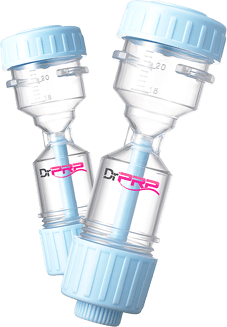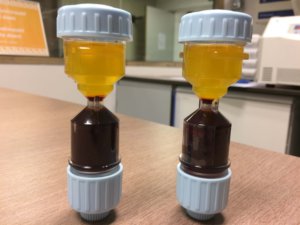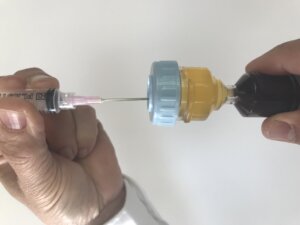Product introduction
A PRP Kit contains tools for concentrating and extracting blood platelets and adjusting blood plasma levels. DS Biologicals has successfully applied its proprietary technology and developed a kit for separating plasma and enriching it with high concentrations of platelets.

Product features
These are what sets DS Biologicals Dr. PRP apart from conventional PRP kits.
Safety
We have built safety and reliability of the Dr. PRP Kit by exclusively using biocompatibility-certification completed raw materials as well as thorough gamma-ray sterilization system according the ISO11137.
One Step-Simplicity
Contamination from surrounding air during the concentration of platelets is blocked by adopting the one-Kit system and double safety cap. Because of this feature, the secondary contamination possibility is minimized unlike the cases of the similar products in the market.
Speed & Convenience
The Buffy coat layer can be conveniently and easily identified by any ordinary person that precise separation of highly concentrated PRP is easily done.
Compatibility
Any swinging bucket type centrifuge may be compatible with Dr. PRP Kit.
Why use a PRP kit?
In preparing PRP, whole blood has to be centrifuged into three layers based on their density levels. The middle layer, which is called the buffy coat, has the highest concentration of platelets. A specialized PRP kit should be capable of separating this layer clean from the other two layers. PRP, in its most ideal form, has a low red blood cell count and a very high platelet-to-plasma ratio. PRP that has been prepared with a conventional PRP kit is usually red in color because it has a higher concentration of red blood cells. Dr. PRP kit, on the other hand, is highly capable of separating red blood cells from the buffy coat and indeed produces the most ideal PRP.


How does PRP work?
After the PRP injection the platelets start with the release of growth factors and the attraction of
white blood cells to clean the area.
The growth factors can create the first inflammatory stage wich can last for about 7 days.
This stage is followed by a proliferation state wich can last for about 6 weeks (cicatrisation).
When those 7 weeks have passed the regeneration can start. This final stage can last from 6 weeks
up to 6 months.
Conclusion
Expected results will take up to at least 2 months!
Our main advantage: every possible PRP solution!
Leukocyte-Rich Platelet-Rich Plasma (with or without addition of ACD-A):
- Leukocyte-rich PRP with a volume of 1 ml and a concentrate of + 10 to 12 x the normal
number of platelets in the blood, with a small number of red blood cells. - Leukocyte-rich PRP with a volume of 2 ml and a concentrate of + 5 to 6 x the normal number
of platelets in the blood, with a small number of red blood cells. - Leukocyte-rich PRP with a volume of 3 ml and a concentrate of + 3 to 4 x the normal number
of platelets in the blood, with a small number of red blood cells. - Leukocyte-rich PRP with a volume of 4 ml and a concentrate of + 2.5 to 3 x the normal
number of platelets in the blood, with a small number of red blood cells.
Ultimately, a Leukocyte-Rich PRP can be created up to a volume of 10 ml, whereby the
concentrate will decrease as the volume increases, and with a small number of red blood
cells present.
- Leukocyte-rich PRP with a volume of 1 ml and a concentrate of 8 to 10 x the normal number
of platelets in the blood, without red blood cells. - Leukocyte-rich PRP with a volume of 2 ml and a concentrate of 4 to 5 x the normal number of
platelets in the blood, without red blood cells. - Leukocyte-rich PRP with a volume of 3 ml and a concentrate of 3 to 4 x the normal number of
platelets in the blood, without red blood cells. - Leukocyte-rich PRP with a volume of 4 ml and a concentrate of 2 to 3 x the normal number of
platelets in the blood, without red blood cells.
Ultimately, a Leukocyte-Rich PRP can be created up to a volume of 10 ml, whereby the
concentrate will decrease as the volume increases, and where no red blood cells are
present.
Leukocyte-poor Platelet-Poor Plasma with or without the addition of ACD-A:
- Leucocyte-poor PPP with a volume of 1 ml to 10 ml, the concentrate at 1 ml being
approximately x 2, but as the volume increases the concentrate also decreases, and one
ultimately has a maximum platelet concentrate that is equal or lower that which is in the
patient’s non-centrifuged blood, namely 1 or less.
Leukocyte-Rich Platelet-Rich Fibrin (gel) without the addition of ACD-A:
- Leukocyte-rich PRF where different amounts of 1 to 8 ml can be created, whereby the
platelet concentrate will decrease again as the volume increases, with a small number or no
red blood cells.
Leukocyte-poor Platelet-Poor Fibrin (gel) without addition of ACD-A :
- Leukocyte-poor PPF where again different amounts of 1 to 8 ml can be created, whereby the
platelet concentrate will decrease even more as the volume increases, without red blood
cells, but with a particularly low platelet count.
Leukocyte-Rich Platelet-Rich Fibrin membrane, without addition of ACD-A :
- Leukocyte-rich PRF membrane in which again different quantities of 1 to 5 ml can be created,
whereby the platelet concentrate will decrease as the volume increases, with a few red blood
cells.
Leukocyte-poor Platelet-Poor Fibrin membrane, without addition of ACD-A :
- Leukocyte-poor PRF membrane, in which again different quantities of 1 to 5 ml can be
created, but in which the platelet concentrate will decrease even more as the volume
increases, without red blood cells.
